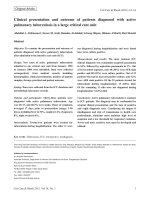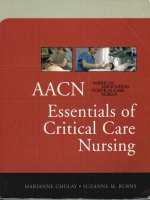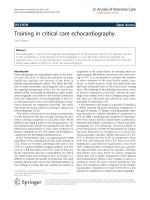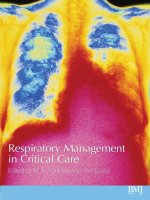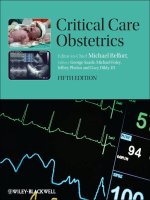surgical critical care vivas
Bạn đang xem bản rút gọn của tài liệu. Xem và tải ngay bản đầy đủ của tài liệu tại đây (836.63 KB, 247 trang )
Surgical Critical
Care Vivas
Greenwich Medical Media Limited
Mazyar Kanani BSc (Hons) MBBS
(Hons) MRCS (Eng)
Surgical Critical Care Vivas
For my wife, Pauline Cornelia O’Keeffe
Surgical Critical Care Vivas
Mazyar Kanani BSc (Hons) MBBS (Hons) MRCS (Eng)
British Heart Foundation
Paediatric Cardiothoracic Clinical Research Fellow
Cardiac Unit
Great Ormond Street Hospital
London, UK
LONDON
᭹
SAN FRANCISCO
www.greenwich-medical.co.uk
© 2003
Greenwich Medical Media Limited
137 Euston Road, London
NW1 2AA
870 Market Street, Ste 720
San Francisco, CA 94102
ISBN 1 84110 1311
First Published 2003
While the advice and information in this book is believed to be true and accurate,
neither the authors nor the publisher can accept any legal responsibility or liabil-
ity for any loss or damage arising from actions or decisions based in this book.The
ultimate responsibility for the treatment of patients and the interpretation lies with
the medical practitioner.The opinions expressed are those of the authors and the
inclusion in this book of information relating to a particular product, method or
technique does not amount to an endorsement of its value or quality, or of the
claims made by its manufacturer. Every effort has been made to check drug
dosages; however, it is still possible that errors have occurred. Furthermore, dosage
schedules are constantly being revised and new side-effects recognised. For these
reasons, the medical practitioner is strongly urged to consult the drug companies'
printed instructions before administering any of the drugs mentioned in this book.
Apart from any fair dealing for the purposes of research or private study, or criticism
or review, as permitted under the UK Copyright Designs and Patents Act 1988, this
publication may not be reproduced, stored, or transmitted, in any form or by any
means, without the prior permission in writing of the publishers, or in the case of
reprographic reproduction only in accordance with the terms of the licences issued
by the appropriate Reproduction Rights Organisations outside the UK. Enquiries
concerning reproduction outside the terms stated here should be sent to the
publishers at the London address printed above.
The rights of Mazyar Kanani to be identified as authors of this work have been
asserted by them in accordance with the Copyright Designs and Patents Act 1988.
The publisher makes no representation, express or implied, with regard to the
accuracy of the information contained in this book and cannot accept any legal
responsibility or liability for any errors or omissions that may be made.
A catalogue record for this book is available from the British Library.
Typeset by Mizpah Publishing Services, Chennai, India
Printed by the Alden Group, Oxford
Distributed by Plymbridge Distributors Ltd and
in the USA by Jamco Distribution
CONTENTS
᭢
v
CONTENTS
List of Abbreviations viii
Acknowledgements xi
Abdominal Trauma: Investigations 1
Accessing the Thorax 4
Acid-Base 7
Acute Renal Failure (see also table in ‘Low urine output’) 10
Acute Respiratory Distress Syndrome (ARDS) 15
Agitation and Sedation 20
Airway Management 23
Analgesia 26
Aortic Dissection 31
Atelectasis 35
Blood Pressure Monitoring 38
Blood Products 42
Blood Transfusion 46
Brainstem Death and Organ Donation 51
Bronchiectasis 55
Burns 57
Calcium Balance 62
Cardiac Assessment 66
Cardiogenic Shock 68
Central Line Insertion 73
Chronic Renal Failure 78
Coagulation Defects 83
Disseminated Intravascular Coagulation (DIC) 86
ECG I – Basic Concepts 88
ECG II – Rate and Rhythm Disturbances 92
Endotracheal Intubation 97
Enteral Nutrition 101
Extubation and Weaning 104
CONTENTS
Fat Embolism Syndrome 106
Flail Chest 111
Fluid Therapy 114
Haemorrhagic Shock 119
Head Injury I – Physiology 124
Head Injury II – Pathophysiology 127
Head Injury III – Principles of Management 130
Inotropes and Circulatory Support 134
ITU Admission Criteria 139
Jugular Venous Pulse (JVP) 141
Lactic Acidosis 144
Low Urine Output State 146
Magnesium Balance 151
Mechanical Ventilatory Support 153
Metabolic Acidosis (see also ‘Acid-base’ and
and ‘Lactic acidosis’) 156
Metabolic Alkalosis 159
Nutrition: Basic Concepts (see also parenteral
nutrition & TPN) 161
Oxygen: Basic Physiology 165
Oxygen Therapy 169
Parenteral Nutrition (TPN) 171
Pneumonia 173
Pneumothorax 177
Potassium Balance 180
Pulmonary Artery Catheter (see also ‘Central line insertion’) 183
Pulmonary Thromboembolism 187
Pulse Oximetry 192
SURGICAL CRITICAL CARE VIVAS
᭢
vi
SURGICAL CRITICAL CARE VIVAS
CONTENTS
vii
Renal Replacement Therapy 194
Respiratory Assessment 198
Respiratory Failure (see also ‘Oxygen therapy’) 201
Rhabdomyolysis 204
Septic Shock and Multi-Organ Failure 208
Sodium and Water Balance 213
Spinal Injury 216
Systemic Response to Trauma 221
Tracheostomy 225
Transfer of the Critically Ill 229
Tube Thoracostomy (Chest Drain) 231
LIST OF ABBREVIATIONS
LIST OF ABBREVIATIONS
ACTH Adrenocorticotropic hormone
ADH Anti diuretic hormone
ADP Adenosine diphosphate
ALI Acute lung injury
AMP Adenosine monophosphate
APTT Activated partial thromboplastin time
ARDS Acute respiratory distress syndrome
ATLS Advance trauma life support
ATN Acute tubular necrosis
ATP Adenosine triphosphate
ATPase Adenosine triphosphatase
AV Atrioventricular
BBB Blood-brain barrier
2,3 BPG 2,3 Bisphosphoglycerate
CAPD Citrate, Adenine, Phosphate, and Dextrose
cGMP Cyclic guanosine monophosphate
CMV Cytomegalovirus
CO Cardiac output
COPD Chronic obstructive pulmonary disease
CPAP Continuous positive airway pressure
CSF Cerebrospinal fluid
CVP Central venous pressure
CXR Chest radiograph
DIC Disseminated Intravascular Coagulation
DKA Diabetic ketoacidosis
DPL Diagnostic peritoneal lavage
DVT Deep venous thrombosis
ECF Extracellular fluid
ECG Electrocardiogram
ELISA Enzyme linked immunosorbent assay
ESR Erythrocyte sedimentation rate
FFA Free fatty acids
FFP Fresh frozen plasma
FiO
2
Fraction of inspired oxygen
᭢
viii
FRC Functional residual capacity
GCS Glassow coma score
GFR Glomerular filtration rate
HITS Heparin-induced thrombocytopenia syndrome
HIV Human immunodeficiency virus
HLA Human leucocyte antigen
HMSO Her Majesty’s Stationery Office
HRT Hormone replacement therapy
I:E RATIO Inspiratory:Expiratory ratio
ICF Intracellular fluid
ICP Intracranial pressure
IgA Immunoglobulin A
IL Interleukin
IMV Intermittent mandatory ventilation
INR International normalised ratio
IPPV Intermittent positive pressure ventilation
ITU Intensive therapy unit
JVP Jugular venous pulse/pressure
MAP Mean arterial pressure
MI Myocardial infarction
MODS Multi-Organ dysfunction syndrome
MPAP Mean pulmonary artery pressure
MRI Magnetic resonance imaging
MRSA Methicillin resistant Staph. aureus
NG Nasogastric
NJ Nasojejunal
NSAIDs Non-steroidal anti-inflammatory drugs
PA Pulmonary artery
PAF Platelet activating factor
PAOP Pulmonary artery occlusion pressure
PCA Patient-controlled analgesia
PCC Prothrombin complex concentrate
PE Pulmonary embolus
PEEP Positive end-expiratory pressure
PSV Pressure support ventilation
PTH Parathormone
PVR Pulmonary vascular resistance
SURGICAL CRITICAL CARE VIVAS
LIST OF ABBREVIATIONS
᭢
ix
LIST OF ABBREVIATIONS
RAA Renin-angiotensin-aldosterone
SAMG Saline,Adenine, Mannitol, and Glucose
SaO
2
Arterial oxygen saturation
SIADH Syndrome of inappropriate ADH
SIMV Synchronised intermittent mandatory ventilation
SIRS Systemic inflammatory response syndrome
SLE Systemic lupus erythmatosus
SVC Superior caval vein
SvO
2
Mixed venous oxygen saturation
SVR Systemic vascular resistance
SVT Supra-ventricular tacycardia
TB Tuberculosis
TNF Tumour necrosis factor
TPN Parenteral nutrition
TT Thrombin time
TURP Trans-urethral resection of the prostate
V/Q RATIO Ventilation/perfusion ratio
VA Alveolar ventilation
VSD Ventricular septal defect
SURGICAL CRITICAL CARE VIVAS
x
ACKNOWLEDGEMENTS
This project would not have been possible without the unfailing
support and encouragement of Miss Marjan Jahangiri, Consultant
Cardiac Surgeon to St George’s Hospital, London. It is also a pleas-
ure to acknowledge Gavin Smith and Gill Clark, publishers at
GMM, whose enthusiasm from the outset made all the difference.
SURGICAL CRITICAL CARE VIVAS
ACKNOWLEDGEMENTS
xi
This page intentionally left blank
ABDOMINAL TRAUMA:
INVESTIGATIONS
What are the two major types of abdominal trauma?
The two types of injury are blunt and penetrating. The
abdomen may be considered as being composed of five parts:
᭹
Abdominal wall: front and back
᭹
Subcostal portion: containing the stomach, liver, spleen and
lesser sac
᭹
Pelvic portion: containing the rectum, internal genitalia and
iliac vessels
᭹
Intraperitoneal portion in between the above: containing
the small and large bowel
᭹
Retroperitoneum: containing the kidneys, urinary tract,
great vessels, pancreas and the rest of the colon
Which abdominal organs are most commonly
injured?
The three most commonly injured organs are the liver, spleen
and kidneys.
How may suspected injuries be investigated?
The initial investigations performed to assess the abdomen as
a whole are
᭹
Plain radiography: also assesses the bony pelvis
᭹
Ultrasound: particularly good for the presence of free
f luid in the abdomen, or haematoma around solid organs.
There is a 10% risk of missing a signif icant injury
᭹
Diagnostic peritoneal lavage (DPL): this is 98% sensitive
for intra-peritoneal bleeding
᭹
CT scanning: this can be used if the results of the DPL are
equivocal, and may also be performed at the same time as
a brain scan. Very good for retroperitoneal injury, less so
for hollow viscus injury such as the bowel
SURGICAL CRITICAL CARE VIVAS
A
ABDOMINAL TRAUMA: INVESTIGATIONS
᭢
1
A
ABDOMINAL TRAUMA: INVESTIGATIONS
Under which circumstances would you perform a
diagnostic peritoneal lavage (DPL)?
Some of the indications are
᭹
A suspicion of abdominal trauma on clinical examination
᭹
Unexplained hypotension: with the abdomen being the
source of occult haemorrhage
᭹
Equivocal abdominal examination because of head injury
and reduced level of consciousness
᭹
The presence of a wound that has traversed the
abdominal wall, but there is no indication for immediate
laparotomy, e.g. a stab wound in a stable patient
When is DPL contraindicated?
The most important contraindication for DPL is in the
situation which calls for mandatory laparotomy, e.g. frank
peritonitis following trauma, abdominal gunshot injury or a
hypotensive patient with abdominal distension.
How is DPL most commonly performed?
Performance of a DPL by the open method
᭹
Requires an aseptic technique
᭹
The abdomen is decompressed by insertion of a urinary
catheter and nasogastric tube
᭹
Local anaesthetic is administered to the subumbilical area
in the mid-line
᭹
An incision is made over this point. If a pelvic fracture is
suspected, then a supraumbilical incision is made to
prevent haematoma disruption
᭹
Dissection is performed down to the peritoneum and the
cannula is inserted under direct vision, guiding it towards
the pelvis
᭹
One litre of warmed saline is infused. Tilting and gently
rolling the patient helps distribution
᭹
The bag of saline can be left on the f loor to siphon off
the sample f luid from the abdomen
SURGICAL CRITICAL CARE VIVAS
᭢
2
What are the positive criteria with DPL?
᭹
Lavage f luid appears in the chest drain or urinary catheter
᭹
Frank blood on entering the abdomen
᭹
Presence of bile or faeces
᭹
Red cell count of Ͼ100,000/l
᭹
White cell count of Ͼ500/l
᭹
Amylase of Ͼ175 U/ml
SURGICAL CRITICAL CARE VIVAS
A
ABDOMINAL TRAUMA: INVESTIGATIONS
3
A
ACCESSING THE THORAX
ACCESSING THE THORAX
In which major ways may the thorax be accessed?
᭹
Percutaneous methods
Needle thoracostomy: to drain f luid, air or for biopsy of
tissue
Tube thoracostomy (‘chest drain’): for drainage of air or
f luid
Thoracoscopic surgery: permits procedures such as
lung/pleural biopsy, lobectomy, pleurodesis,
pleurectomy, sympathectomy, pericardiocentesis and
pericardial window
᭹
Thoracotomy
Median sternotomy: from the top of the manubrium at
the jugular notch, passing longitudinally through the
sternum to the xiphisternum. It permits access to the
pericardium, great vessels, and both hemithoraces
Posterolateral thoracotomy: the most common
approach in thoracic surgery. The incision runs from a
point mid-way between the medial scapular edge and
the thoracic spine, following a curve that runs 2 cm
below the inferior scapular angle, to the mid-point of
the axilla
Anterior thoracotomy: from the sternal edge, curving
laterally along the intercostal space below the nipple to
the axilla. It allows lung, pericardial and lung access, and
also to lymph nodes in the aorto-pulmonary window
Posterior thoracotomy: the line of the incision is
similar to that of a posterolateral thoracotomy, but starts
at a more posterior point, encroaching on to the
trapezius and erector spinae muscles. It allows access to
the lung and great vessels for some paediatric cardiac
procedures
Bilateral anterior sternotomy (‘clamshell’ incision):
this incision runs from below one nipple to the
contralateral side, dividing the body of the sternum
in-between. It permits emergency access to the
SURGICAL CRITICAL CARE VIVAS
᭢
4
pericardium and simultaneous exposure of both pleural
cavities
Thoraco-laparotomy: the incision runs like that of a
posterolateral thoracotomy, but continues anteriorly to
cross the costal margin at the junction of the sixth and
seventh ribs. The line runs for another 5 cm into the
abdominal wall. It is extended inferiorly as a para-
median or mid-line laparotomy. It permits access to
posterior mediastinal structures, such as the aorta or
oesophagus as they run into the abdomen
᭹
Mediastinoscopy: the incision runs across the anterior
neck, two fingers-breadth above the jugular notch. Allows
access to the sub-carinal lymph nodes for disease diagnosis
and staging
Which important piece of anaesthetic equipment is
required for thoracotomy, and why?
The double-lumen endobronchial tube. This permits the use
of one-lung anaesthesia where one lung may be collapsed and
inf lated at will for the purposes of surgery. This is particularly
important for thoracoscopy where one lung has to be col-
lapsed to permit the safe passage of the instruments through
the thoracic wall.
What is the important pre-requisite to closure of all
thoracotomies?
Chest drain insertion. Post cardiac surgery, one or two drains
may be inserted into the mediastinum/posterior peri-
cardium, exiting through the skin subcostally. Other drains
are placed into any opened pleural space, e.g. during internal
mammary artery harvest. After thoracotomy, one apical and
one basal chest drain may be placed, both exiting sub-costally.
Briefly mention some important local complications
of thoracotomy.
Wound complications
᭹
Early:
Immediate dehiscence from poor technique
SURGICAL CRITICAL CARE VIVAS
A
ACCESSING THE THORAX
᭢
5
A
ACCESSING THE THORAX
Haematoma formation
Poor pain control leading to atelectasis, retention of
secretions, hypoxia and infection
᭹
Intermediate:
Infection, leading to wound dehiscence
᭹
Late:
Post-thoracotomy neuralgia
Pulmonary complications
᭹
Early:
Air leak: seen as continuous bubbling from the drains
when placed on suction. May be due to parenchymal
injury or a leak from the suture-line of a bronchial
stump
Bleeding: producing haemothorax. May be from the
raw parenchymal surface, or from a larger vessel
᭹
Intermediate:
Pneumonia: can lead to a lung abscess
Pulmonary oedema: seen particularly in the contralateral
lung following pneumonectomy. May also occur
following re-expansion of a chronically collapsed or
compressed lung from effusion
᭹
Late:
Chronic broncho-pleural fistula
Empyema
SURGICAL CRITICAL CARE VIVAS
6
ACID-BASE
Define the pH.
The pH is Ϫlog
10
[H
ϩ
].
What is the pH of blood?
7.36–7.44.
Where does the acid load (H
؉
) in the body come
from?
Most of the H
ϩ
in the body comes from CO
2
generated from
metabolism. This enters solution, forming carbonic acid
through a reaction mediated by the enzyme carbonic anhy-
drase.
Acid is also generated by
᭹
Metabolism of the sulphur-containing amino acids
cysteine and methionine
᭹
Anaerobic metabolism, generating lactic acid
᭹
Generation of the ketone bodies acetone, acetoacetate and
-hydroxybutyrate
What are the main buffer systems in the intravascular,
interstitial and intracellular compartments?
In the plasma the main systems are
᭹
The bicarbonate system
᭹
The phosphate system
᭹
Plasma proteins
᭹
Globin component of haemoglobin
Interstitial: the bicarbonate system
Intracellular: cytoplasmic proteins
What does the Henderson–Hasselbalch equation
describe, and how is it derived?
This equation, which may be applied to any buffer system,
defines the relationship between dissociated and undissociated
2+
424
(HPO + H H PO )
ϪϪ
22 23 3
CO HO HCO H HCO
+−
++
SURGICAL CRITICAL CARE VIVAS
A
ACID-BASE
᭢
7
A
ACID-BASE
acids and bases. It is used mainly to describe the equilibrium
of the bicarbonate system.
The dissociation constant,
Therefore
Taking the log
Taking the negative log, which expresses the pH, and where
Ϫlog K is the pK
Invert the term to remove the minus sign
The [H
2
CO
3
] may be expressed as pCO
2
ϫ 0.23, where 0.23
is the solubility coefficient of CO
2
(when the pCO
2
is in kPa).
The pK is equal to 6.1.
Thus,
Which organ systems are involved in regulating
acid-base balance?
The main organ systems involved in regulating acid-base
balance are
3
2
[HCO ]
pH 6.1 log .
pCO 0.23
−
=+
×
3
23
[HCO ]
pH pK log
[H CO ]
−
=+
23
3
[H CO ]
pH pK log
[HCO ]
−
=−
23
3
[H CO ]
log[H ] log K log
[HCO ]
+
−
=+
23
3
[H CO ]
[H ] K
[HCO ]
+
−
=
3
23
[H ][HCO ]
K
[H CO ]
+−
=
22 23 3
CO HO HCO H HCO
+−
++
SURGICAL CRITICAL CARE VIVAS
᭢
8
᭹
Respiratory system: this controls the pCO
2
through
alterations in alveolar ventilation. Carbon dioxide
indirectly stimulates central chemoceptors (found in the
ventro-lateral surface of the medulla oblongata) through
H
ϩ
released when it crosses the blood-brain barrier
(BBB) and dissolves in the cerebrospinal f luid (CSF)
᭹
Kidney: this controls the [HCO
3
Ϫ
], and is important for
long term control and compensation of acid-base
disturbances
᭹
Blood: through buffering by plasma proteins and
haemoglobin
᭹
Bone: H
ϩ
may exchange with cations from bone mineral.
There is also carbonate in bone that can be used to
support plasma HCO
3
Ϫ
levels
᭹
Liver: this may generate HCO
3
Ϫ
and NH
4
ϩ
(ammonia)
by glutamine metabolism. In the kidney tubules, ammonia
excretion generates more bicarbonate
How does the kidney absorb bicarbonate?
There are three main methods by which the kidneys increase
the plasma bicarbonate
᭹
Replacement of filtered bicarbonate with bicarbonate
that is generated in the tubular cells
᭹
Replacement of filtered phosphate with bicarbonate that
is generated in the tubular cells
᭹
By generation of ‘new’ bicarbonate from glutamine that is
absorbed by the tubular cell
Define the base deficit.
The base deficit is the amount of acid or alkali required to
restore 1 l of blood to a normal pH at a pCO
2
of 5.3 kPa and
at 37°C. It is an indicator of the metabolic component to an
acid-base disturbance. The normal range is Ϫ2 to ϩ2 mmol/l.
SURGICAL CRITICAL CARE VIVAS
A
ACID-BASE
9
A
ACUTE RENAL FAILURE
ACUTE RENAL FAILURE
What is the definition of acute renal failure?
This is the inability of the kidney to excrete the nitrogenous
and other waste products of metabolism and can develop over
the course of a few hours or days. It is therefore a biochem-
ical diagnosis
How are the causes basically classified?
The causes may be considered to be pre-renal, renal or post-
renal.
What are the major ‘renal’ causes of acute renal
failure?
᭹
Acute tubular necrosis
᭹
Glomerulonephritis
᭹
Interstitial nephritis
᭹
Bilateral cortical necrosis
᭹
Reno-vascular: vasculitis, renal artery thrombosis
᭹
Hepatorenal syndrome
What is acute tubular necrosis?
Acute tubular necrosis is renal failure resulting from injury to
the tubular epithelial cells, and is the most important cause of
acute renal failure. There are two types
᭹
Ischaemic injury: following any cause of shock with
resulting fall in the renal perfusion pressure and
oxygenation
᭹
Nephrotoxic injury: from drugs (aminoglycosides,
paracetamol), toxins (heavy metals, organic solvents), or
myoglobin (from rhabdomyolysis)
SURGICAL CRITICAL CARE VIVAS
᭢
10
What are the major ‘post-renal’ causes?
᭹
Acute obstruction from calculi
᭹
Obstruction from tumours arising from the renal
parenchyma or transitional epithelium of the
pelvi-calyceal system
᭹
Extrinsic compression from pelvic tumours
᭹
Iatrogenic injury, e.g. inadvertent damage to the ureters
during bowel surgery
᭹
Prostatic obstruction
᭹
Increased intra-abdominal pressure (>30 cmH
2
O)
Which part of the kidney is the most poorly perfused?
The renal medulla is more poorly perfused than the cortex.
This ensures that the medullary interstitial concentration
gradient formed by tubular counter current multiplication is
preserved and maintained.
Which part of the nephron is the most susceptible to
ischaemic injury, and why?
The cells of the thick ascending limb are the most susceptible
to ischaemic injury for two important reasons
᭹
The cells reside in the medulla, which has poorer
oxygenation than the cortex
᭹
The active Na
ϩ
-K
ϩ
ATPase pumps at the cell membrane
have a high oxygen demand
What are the basic steps in the pathogenesis of acute
renal failure?
The basic steps in the pathogenesis are
᭹
Initially, there is renal parenchymal ischaemia: as part of
the compensatory response to a fall in the renal perfusion
pressure, there is vasoconstriction of the efferent arteriole.
Thus, by reducing the pre to post capillary resistance ratio,
the capillary filtration pressure is preserved at the expense
of reducing the blood supply to the tubules from the
efferent arteriole and vasa recta. This leads to worsening
cortical and medullary ischaemia
SURGICAL CRITICAL CARE VIVAS
A
ACUTE RENAL FAILURE
᭢
11

